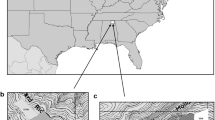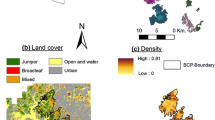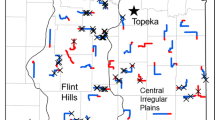Abstract
Wildlife conservation and management on military lands must be accomplished in the context of military readiness, which often includes ground-based training that is perceived to conflict with wildlife needs and environmental regulations. From 2008‒2012, we examined territory density, pairing success, and fledging success of the federally endangered golden-cheeked warbler (Setophaga chrysoparia; hereafter warbler) in relation to removal of small-diameter trees from the understory of mature oak-juniper (Quercus-Juniperus) woodland at the 87,890 ha Fort Hood Military Reservation in central Texas. Understory thinning created troop maneuver lanes, but left canopy vegetation intact. Warbler density, pairing success, and fledging success were similar across thinned and control sites. We found that warbler pairing and fledging success were best predicted by Ecological site (hereafter Ecosite), an indicator of hardwood tree species composition. Warbler pairing and fledging success were about 1.5 and 1.6 times higher, respectively, for territories dominated by the Low Stony Hill Ecosite than territories dominated by the Redlands Ecosite. Our results indicate that understory thinning for military training purposes did not have a negative effect on warblers at Fort Hood in the manner tested, and suggest that removal of smaller trees from the understory in a way that replicates historic conditions may elicit neutral responses from this forest-dependent songbird. Quantifying wildlife responses to military activities provides the Department of Defense and US Fish and Wildlife Service with data to guide conservation of threatened and endangered species on Department of Defense facilities while maintaining the military mission, and supports wildlife management efforts on other public and private lands.




Similar content being viewed by others
References
Annand EM, Thompson III FR (1997) Forest bird response to regeneration practices in central hardwood forests. J Wildl Manag 61:159–171
Artman VL (2003) Effects of commercial thinning on breeding bird populations in western hemlock forests. Am Midl Nat 149:225–232
Atwell RC, Schulte LA, Palik BJ (2008) Songbird response to experimental retention harvesting in red pine (Pinus resinosa) forests. For Ecol Manag 255:3621–3631
Boice LP (2006) Defense and conservation: compatible missions. Endanger Species Bull 31:4–7
Burnham KP, Anderson DR (2002) Model Selection and Multimodal Inference. Springer-Verlag: New York.
Creque JA, Bassett SD, West NE (1999) Viewpoint: delineating ecological sites. J Range Manag 52:546–549
Diamond DD (1997) An old-growth definition for western juniper woodlands: Texas Ashe juniper dominated or codominated communities. General Technical Report SRS-15 for US Department of Agriculture, Forest Service, Southern Research Station, Asheville, North Carolina, Unites States.
Diggs G, Lipscomb B, Reed M, O’Kennon R (2006) Illustrated flora of East Texas, Vol. 1. Botanical Research Institute of Texas, Fort Worth, TX
Eggers S, Low M (2014) Differential demographic responses of sympatric Parids to vegetation management in boreal forest. For Ecol Manag 319:169–175
Farrell SL, Morrison ML, Campomizzi AJ, Wilkins RN (2012) Conspecific cues and breeding habitat selection in an endangered woodland warbler. J Anim Ecol 81:1056–1064
Franklin JF, Berg DR, Thornburgh DA, Tappeiner JC (1997) Alternative silvicultural approaches to timber harvesting: variable retention harvest systems. In: Kohm KA, Franklin JF (eds) Creating a forestry for the 21st century. Island, Washington DC, WA, pp. 111–139
Fuhlendorf SD, Smeins FE, Grant WE (1996) Simulation of a fire-sensitive ecological threshold: A case study on the Edwards Plateau of Texas, USA. Ecol Model 90:245–255
Gorte RW, Vincent CH, Hanson LA, Rosenblum MR (2012) Federal land ownership: Overview and data. Congressional Research Service Report for Congress 7-5700, Washington, DC
Griffith GE, Bryce SA, Comstock JA, Rogers AC, Harrison B, Hatch SL, Bezanson D (2004) Ecoregions of Texas (color poster with map, descriptive text, and photographs). US Geological Survey: Reston, VA.
Groce JE, Mathewson HA, Morrison ML, Wilkins N (2010) Scientific evaluation for the 5-year status review of the golden-cheeked warbler. Report prepared for the Texas Parks and Wildlife Department, Austin, TX and to the US Fish and Wildlife Service, Region 2, Albuquerque, NM. http://www.fws.gov/southwest/es/documents/r2es/groce_et_al_2010_gcwa_status_review.pdf. Accessed 25 April 2015
Hagar J, Friesen C (2009) Young stand thinning and diversity study: Response of songbird community one decade post treatment: U.S. Geological Survey Open-File Report 2009-1253
Halpern CB, McKenzie D, Evans SA, Maguire DA (2005) Initial responses of forest understories to varying levels and patterns of green-tree retention. Ecol Appl 15:175–195
Johnson DH (1999) The insignificance of statistical significance testing. J Wildl Manag 63:763–772
King DI, DeGraaf RM (2000) Bird species diversity and nesting success in mature, clearcut and shelterwood forest in northern New Hampshire. For Ecol Manag 129:227–235
Klassen JA, Morrison ML, Mathewson HA, Rosenthal GG, Wilkins RN (2012) Canopy characteristics affect reproductive success of golden-cheeked warblers. Wildl Soc Bull 36:54–60
Ladd C, Gass L (1999) Golden-cheeked warbler (Setophaga chrysoparia) In: Poole, A (ed) The birds of North America online. http://bna.birds.cornell.edu/bna/species/420. Accessed 25 April 2015
Long AM (2014) The influence of tree species composition on songbird abundance and productivity. Dissertation, Texas A&M University
Lyons JE (2005) Habitat specific foraging of prothonotary warblers. Condor 107:41–49
Marshall ME, Morrison ML, Wilkins RN (2013) Tree species composition and food availability affect productivity of an endangered species: the golden-cheeked warbler. Condor 115:882–892
Moore MM, Covington WW, Fule PZ (1999) Reference conditions and ecological restoration: a southwestern ponderosa pine perspective. Ecol Appl 9:1266–1277
Morrison SA, Bolger DT (2002) Variation in a sparrow’s reproductive success with rainfall: food and predator-mediated processes. Popul Ecol 133:315–324
NatureServe (2015) Species at risk on Department of Defense lands: 2014 updated analysis, report, and maps. Report prepared for US Department of Defense. http://www.denix.osd.mil/nr/upload/Species-at-Risk-on-Department-of-Defense-Lands-2014-Updated-Analysis-Report-and-Maps-Report-Legacy-14-772.pdf. Accessed 25 April 2015
Palik BJ, Mitchell RJ, Pecot S, Battaglia M, Pu M (2003) Spatial distribution of overstory retention influences resources and growth of longleaf pine seedlings. Ecol Appl 13:674–686
Powell LA, Lang JD, Conroy MJ, Krementz DG (2000) Effects of forest management on density, survival, and population growth of wood thrushes. J Wildl Manag 64:11–23
Pulich WM (1976) The golden-cheeked warbler: A bioecological study. Texas Parks and Wildlife Department, Austin, TX
R Development Core Team (2013) R: A language and environment for statistical computing. R Foundation for Statistical Computing, Vienna
Rodewald PG, Smith KG (1998) Short-term effects of understory and overstory management on breeding birds in Arkansas oak-hickory forests. J Wildl Manag 62:1411–1417
Rodewald AD, Yahner RH (2001) Avian nesting success in forested landscapes: Influence of landscape composition, stand and nest-patch microhabitat, and biotic interactions. Auk 118:1018–1028
Sparks JC, Stambaugh MC, Keith EL (2012) Restoring fire suppressed Texas oak woodlands to historic conditions using prescribed fire. In: Dey DC, Stambaugh, MC, Clark SL, Schweitzer CJ (eds) Proceedings of the 4th Fire in Eastern Oak Forests Conference. General Technical Report NRS-P-102. US Department of Agriculture Forest Service, Northern Research Station, Newtown, PA, pp 127–141
Stein BA (2008) Biodiversity and the military mission. In: Benton N, Ripley JD, Powledge F (eds) Conserving Biodiversity on Military Lands: A Guide for Natural Resources Managers, http://www.dodbiodiversity.org
Stein BA, Scott C, Benton N (2008) Federal lands and endangered species: the role of military and other federal lands in sustaining biodiversity. BioSci 58:339–347
Sugiura N (1978) Further analysts of the data by Akaike’s information criterion and the finite corrections. Commun Stat Theory Methods 7:13–26
Tazik DJ, Martin CO (2002) Threatened and endangered species on US department of defense lands in the Arid West, USA. Arid Land Res Manag 16:259–276
Thompson IIIFR, Probst JR, Raphael MG (1995) Impacts of silviculture: Overview and management recommendations. In: Martin TE, Finch DM (eds) Ecology and management of Neotropical migratory birds. Oxford Univ Press, New York, NY, pp 201–219
USDA-NRCSa (United States Department of Agriculture Natural Resources Conservation Service) (2011a) Ecological site characteristics: Low stony hill 23-31” PZ. https://esis.sc.egov.usda.gov/ESDReport/fsReport.aspx?approved=yes&rptLevel=all&id=R081BY337TX. Accessed 24 April 2015
USDA-NRCSb (United States Department of Agriculture Natural Resources Conservation Service) (2011b) Ecological site characteristics: Redland 29-35” PZ. https://esis.sc.egov.usda.gov/ESDReport/fsReport.aspx?approved=yes&rptLevel=all&id=R081CY361TX. Accessed 24 April 2015
USDA-NRCSc (United States Department of Agriculture Natural Resources Conservation Service) (2011c) Ecological site characteristics: Steep adobe 23-31” PZ. https://esis.sc.egov.usda.gov/ESDReport/fsReport.aspx?approved=yes&rptLevel=all&id=R081BY348TX. Accessed 13 January 2016
USFWS (United States Fish and Wildlife Service/Southeast Region) (2003) Recovery plan for the red-cockaded woodpecker: Second revision. U.S. Fish and Wildlife Service, Atlanta, GA
Vickery PD, Hunter ML, Wells JV (1992) Use of a reproductive index to evaluate relationships between habitat quality and breeding success. Auk 109:697–705
Acknowledgements
We thank the US Army Environmental Command (Fort Hood Military Reservation) for funding and the research team at the Texas A&M Institute of Renewable Natural Resources for logistical support. We also thank Justin Tatum and Reynaldo Navarro for assisting with study site access and guidance applicable to our research objectives. Andy James provided comments on earlier drafts and many field technicians contributed to data collection.
Author information
Authors and Affiliations
Corresponding author
Ethics declarations
Conflict of Interest
The authors declare no Conflict of Interest.
Rights and permissions
About this article
Cite this article
Long, A.M., Marshall, M.E., Morrison, M.L. et al. Responses of a Federally Endangered Songbird to Understory Thinning in Oak-Juniper Woodlands. Environmental Management 59, 684–692 (2017). https://doi.org/10.1007/s00267-016-0810-3
Received:
Accepted:
Published:
Issue Date:
DOI: https://doi.org/10.1007/s00267-016-0810-3




